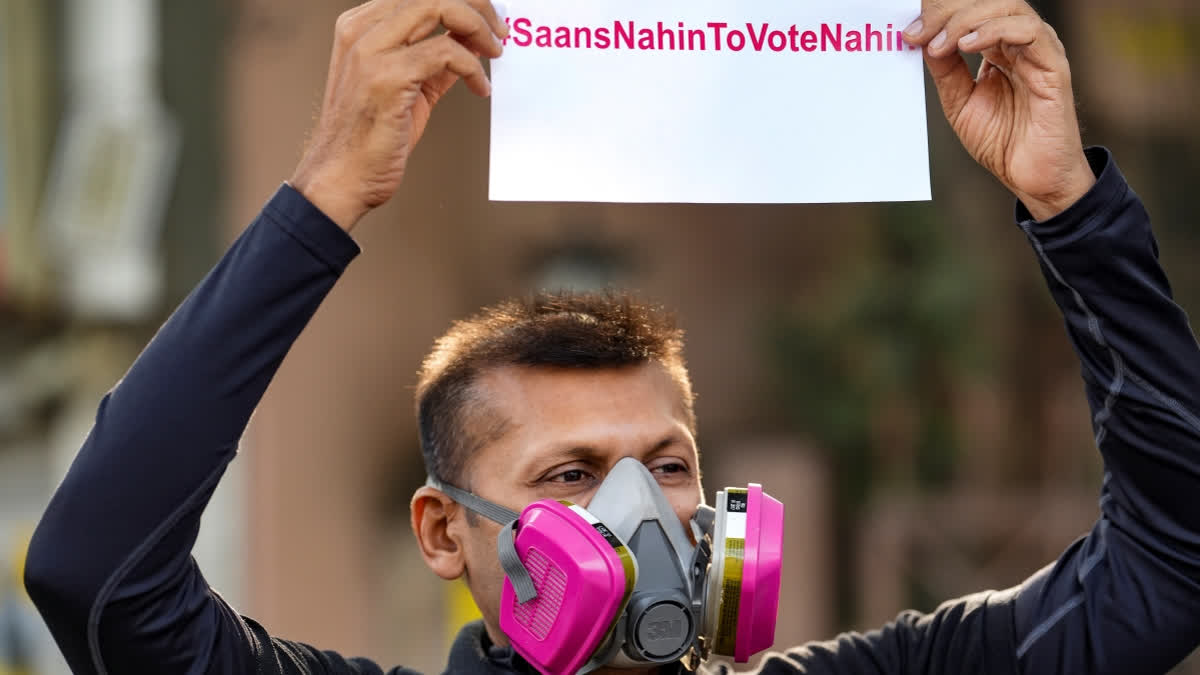New Delhi:Delhi’s air quality continues to remain in the ‘inferior’ category, with the Air Quality Index (AQI) recorded at 333 on Friday. Despite consistent winds keeping the skies relatively clear, the city struggles with persistent pollution as winter intensifies, bringing a host of health concerns and restrictions on daily life.
Residents Share Their Struggles: For residents like Amarjeet Singh, who commutes 40 kilometres daily from Delhi to Noida, the pollution crisis is a recurring nightmare.
“Pollution has reduced, but the problems are still the same,” he said. “Cough, cold, and fever are ongoing issues. Antibiotics provide temporary relief, but the problems resurface. My children are confined to the house due to online classes, but for how long can this continue? The government isn’t doing enough to solve pollution.”
Singh likened the experience of daily commuters to smoking multiple cigarettes, stating, “Any person on the road is inhaling 20 cigarettes every day, thanks to this pollution. There is no one to listen or provide solutions.”
Residents complained that the government isn’t doing enough to solve pollution. (ETV Bharat) Another resident, Brij Kishore Dubey, echoed similar concerns. Dubey, a daily bike commuter, pointed out the impact on children and the elderly.
“Schools are partially closed, and pollution is more harmful to vulnerable groups. Children’s online classes mean they are glued to screens all day, affecting their eyesight. When I go to work, I wear a mask to avoid breathing problems,” he said.
CAQM’s Efforts to Tackle Pollution: The Commission for Air Quality Management in the National Capital Region and Adjoining Areas (CAQM) held its 19th meeting on Thursday, focusing on strategies to mitigate pollution.
Key issues included controlling emissions from construction activities, stubble burning, and enhancing the Graded Response Action Plan (GRAP).
One major decision was implementing stricter monitoring and enforcement mechanisms targeting construction and demolition (C&D) sites. Member Secretaries of Pollution Control Boards in NCR states have been empowered to prosecute violators, enabling swift action such as site closures and imposing hefty fines.
Additionally, the CAQM revised policies to reduce vehicular emissions by encouraging hybrid learning modes in schools and colleges to limit daily commutes. Other measures like enhanced parking charges and updates to GRAP schedules were also reviewed.
Stubble Burning and Industrial Emissions: Addressing stubble burning, a significant contributor to pollution in winter, the CAQM updated environmental compensation charges to deter offenders. While incidents of stubble burning have decreased, the commission stressed the importance of sustained vigilance, particularly in Punjab and Haryana.
The CAQM also urged state pollution control boards to intensify inspections of polluting industries and C&D projects. This call to action comes in response to the persistently high AQI levels in the region.
Health Risks and Expert Advice: The Indian Health Ministry has repeatedly highlighted the health risks associated with poor air quality, particularly for children, the elderly, and those with underlying health conditions. Vulnerable populations are advised to remain indoors and limit physical activity during severe pollution levels.
Mahesh Palawat, Vice President of Skymet Weather (a private company providing weather forecasting services), explained the role of meteorological factors in Delhi’s pollution levels.
“Cold northwesterly winds are keeping pollution levels in the ‘very poor’ zone, but wind speeds may drop over the weekend due to a western disturbance. This could raise the minimum temperature slightly and worsen air quality,” he said.
Weather Update: Delhi experienced its coldest night of the season on Thursday, with the minimum temperature dropping to 10.1°C, as per data from the India Meteorological Department (IMD). The Safdarjung Observatory recorded this temperature, but other parts of the city, like Pusa (8.6°C) and Lodhi Road (9.2°C), were even colder.
The maximum temperature was recorded at 27.3°C, slightly above normal. Forecasts suggest the minimum temperature may dip below 10°C on Friday before rising marginally over the weekend.
The Way Forward:Despite multiple measures in place, including emergency provisions under Stage 4 of the GRAP, Delhi’s air quality shows little improvement. Out of 39 air quality monitoring stations in the city, 26 reported ‘very poor’ air quality on Thursday. Mundka emerged as the most polluted area with an AQI of 373, followed by Jahangirpuri at 364.
The Supreme Court has directed the CAQM to continue implementing Stage 4 measures until December 2, when the Commission will reassess whether to scale back to Stage 3 or 2.
While residents continue to grapple with the effects of pollution, experts and authorities urge collective responsibility to combat this crisis. As Mahesh Palawat stated, “Delhi’s air quality is a complex issue influenced by weather, local emissions, and regional factors. Only sustained efforts can bring long-term relief.”
For now, the city awaits tangible improvements as it endures both chilling temperatures and suffocating pollution.
Read More:
- Delhi-NCR Air Quality Improves Slightly But Remains Poor; Experts Warn of Deterioration Ahead
- 'Burning Sensation In Eyes': Lucknow Gasps For Breath As AQI Dips To 'Poor'
- No Respite for Delhi As Toxic Air Worsens Amid Winter Onset
